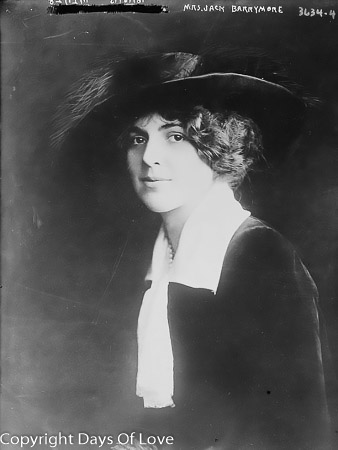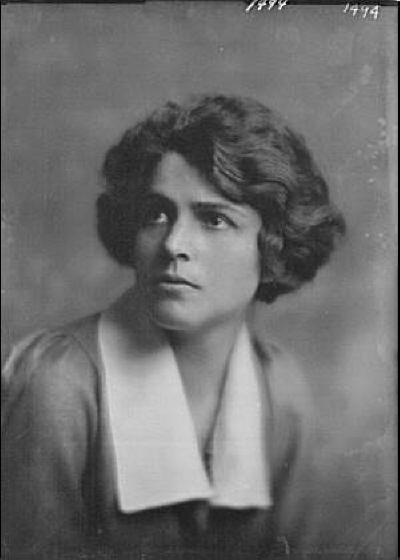Partner Margaret Wise Brown
Queer Places:
10 Gracie Square, New York, NY 10028, Stati Uniti
Woodlawn Cemetery, E 233rd St & Webster Avenue, Bronx, NY 10470, Stati Uniti
 Blanche
Marie Louise Oelrichs (October 1, 1890 – November 5, 1950) was an American
poet, playwright and theatre actress. Oelrichs first used the masculine nom
de plume Michael Strange to publish her poetry in order to distance her
Society reputation from its sometimes erotic content, but it soon became the
name under which she presented herself for the remainder of her life.
Blanche
Marie Louise Oelrichs (October 1, 1890 – November 5, 1950) was an American
poet, playwright and theatre actress. Oelrichs first used the masculine nom
de plume Michael Strange to publish her poetry in order to distance her
Society reputation from its sometimes erotic content, but it soon became the
name under which she presented herself for the remainder of her life.
Born to Charles May Oelrichs and Blanche de Loosey, Blanche Oelrichs was
the youngest of four children.[1]
Her Austrian mother was the sister of Emilie de Loosey, wife of Theodore
Havemeyer. The family spent summers in Newport, Rhode Island, amidst the
Astors, the Vanderbilts, and numerous other wealthy elites of American society
during the Gilded Age.
Her sister Natalie, always known as Lily, married and divorced Heinrich
Borwin, Duke of Mecklenburg (son of Duke Paul Frederick of Mecklenburg), after
the premature death of her first husband Peter Martin of San Francisco. Her
brother, Charles de Loosey was the father of Marjorie Oelrichs who was married
to band leader Eddy Duchin.
Oelrichs was an involved activist for women's suffrage and a writer. French
portrait artist Paul Helleu described Strange as the "most beautiful woman in
America."[2]
In 1910, Oelrichs married her first husband Leonard Moorhead Thomas, the
son of a prominent Philadelphia banker, with whom she had two children,
Leonard Jr. (1911–68)[3]
and Robin May Thomas (1915–44). Leonard Moorhead Thomas was a Yale University
graduate who had worked in the diplomatic service in Rome and Madrid and
served with the United States Army in Europe during World War I, earning the
Croix de Guerre. Blanche Oelrichs developed a "literary urge" in 1914 when she
began creating works of poetry and theatrical plays. Her first collection of
poems was published in 1916 under the pen name Michael Strange. Her interests
caused a rift with her husband and they divorced in 1919.[1]

by
Arnold Genthe
Through her social activities, Strange met renowned actor John Barrymore.
They were introduced by actress Cathleen Nesbitt, Barrymore's leading woman in
the 1916 production of the play Justice. She continued seeing him for
four years; and, after divorcing Thomas, she married Barrymore on August 5,
1920.[4]
She was already several months' pregnant with their only child, Diana Blanche
Barrymore, who was born on March 3, 1921.
With drawings provided by John Barrymore, Strange published a book in 1921
titled Resurrecting Life. Her pseudonym was intended to separate her
Society family from the erotic content of the volume and its connection to her
affair from Barrymore, but instead the vast popularity of the volume led to
greater fame and notoriety, and her adaptation of the Strange name
permanently.[5]
She then turned her writing skills to the creation of theatrical plays
including a 1921 Broadway production titled Clair de lune. Based on
L'Homme qui rit by Victor Hugo, her play starred her husband and his
sister Ethel Barrymore. It was made into a 1932 movie of the same name in
France by director Henri Diamant-Berger.
In 1921, Strange was among the first to join the Lucy Stone League, an
organization that fought for women to preserve their maiden names after
marriage.[6]
Strange spent a great deal of time in Paris, France during the next few
years while her husband performed abroad. After returning to live in New York,
she began acting in live theatre. Her marriage to John Barrymore ended in May
1925. She then joined a summer stock company in Salem, Massachusetts and
appeared in two Broadway plays in 1926 and 1927.
Another book of Strange's poetry was published in 1928 under the title "Selected
poems, by Michael Strange" and the following year she married a third time
to the prominent New York attorney Harrison Tweed who later became Chairman of
Sarah Lawrence College.[7]
During the second half of the 1930s Strange hosted a poetry and music program
on New York radio station WOR that gained a strong audience. In 1940, Strange
published her autobiography, Who Tells Me True. In 1942, she and
Harrison Tweed divorced, and in 1944 her son Robin died at the age of 29.
Starting in the summer of 1940 until her death, Strange was in a long-term
relationship with
Margaret Wise Brown, the author of many children's books.[8]
The relationship began as something of a mentoring one, but became a romantic
relationship and they lived together at 10 Gracie Square beginning in 1943.[9]
Strange was a registered communist and part of the America First
Committee's weekly radio show.[5]
Her final professional tour was Great Works with Great Music, a
recreation of a radio program she had done previously, in which she read great
literature and classical works of music were played.[5]
Michael Strange died from leukemia in 1950 in Boston. She was interred with
her son Robin May Thomas, who
had died in 1944, in the Oelrichs' family plot in the Woodlawn Cemetery in The
Bronx, New York.[10]
Robin had been buried in Indiana with his predeceased lover, but Strange's
will asked for his body to be moved to the rest of the family.[5]
Margaret Wise Brown was made her literary executor. Upon her death two
years later, Strange's papers were delivered to Brown's sister Roberta who
contacted Diana Barrymore who instructed her to burn them.[5]
In 1960 her daughter Diana Barrymore died at age 38 after several years of
drug and alcohol addiction. Her older son Leonard was married to painter
Yvonne Thomas and they had two daughters together, the only grandchildren of
Michael Strange.[11]
My published books:


BACK TO HOME PAGE

- https://en.wikipedia.org/wiki/Michael_Strange
 Blanche
Marie Louise Oelrichs (October 1, 1890 – November 5, 1950) was an American
poet, playwright and theatre actress. Oelrichs first used the masculine nom
de plume Michael Strange to publish her poetry in order to distance her
Society reputation from its sometimes erotic content, but it soon became the
name under which she presented herself for the remainder of her life.
Blanche
Marie Louise Oelrichs (October 1, 1890 – November 5, 1950) was an American
poet, playwright and theatre actress. Oelrichs first used the masculine nom
de plume Michael Strange to publish her poetry in order to distance her
Society reputation from its sometimes erotic content, but it soon became the
name under which she presented herself for the remainder of her life. 

